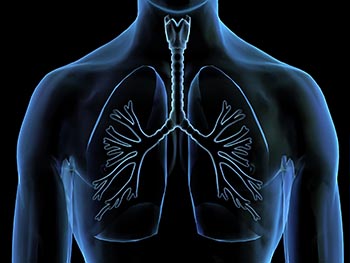 “Fibrosis means scarring, and idiopathic pulmonary fibrosis is a disease of unknown origin that results in scar tissue building up in the lungs,” said Victor Thannickal, M.D., director of the Division of Pulmonary Medicine and the principal investigator for the grant. “IPF affects more than 100,000 people in the United States and five million worldwide. This disease is relentless. The median survival rate is less than three years, and only 20 percent of patients survive five years beyond diagnosis.”
“Fibrosis means scarring, and idiopathic pulmonary fibrosis is a disease of unknown origin that results in scar tissue building up in the lungs,” said Victor Thannickal, M.D., director of the Division of Pulmonary Medicine and the principal investigator for the grant. “IPF affects more than 100,000 people in the United States and five million worldwide. This disease is relentless. The median survival rate is less than three years, and only 20 percent of patients survive five years beyond diagnosis.”Thannickal says the incidence in the United States appears to be rising, due in part to the aging population. He says the cause of IPF is uncertain, although genetics and environmental exposures such as cigarette smoke, along with age, are known risk factors.
The new NIH grant will support ongoing UAB work targeting myofibroblasts, cells responsible for wound healing in the body. In healthy tissues, myofibroblasts assist with wound repair, and then die in a programmed process known as apoptosis. Fibrosis involving the lungs or other organs occurs when myofibroblasts fail to undergo apoptosis, resulting in a persistent repair process. This causes scarring and stiffening of the surrounding tissue, promoting the creation of even more scar tissue — a vicious cycle of nonresolving repair.
The grant will fund three major projects at UAB, which share the unified goal of developing therapeutic agents to target the activated myofibroblast in the treatment of IPF. Anti-fibrotic therapies, if proved effective, may also be tested in other clinical disorders outside the lung characterized by the presence of persistent myofibroblasts.
| The grant will fund three major projects at UAB, which share the unified goal of developing therapeutic agents to target the activated myofibroblast in the treatment of IPF. Anti-fibrotic therapies, if proved effective, may also be tested in other clinical disorders outside the lung characterized by the presence of persistent myofibroblasts. |
A second project, led by Gang Liu, M.D., associate professor of medicine, will focus on microRNAs that are down-regulated, or shut off, during IPF. Liu’s laboratory will look for ways to boost the presence and production of these anti-fibrotic microRNAs.
Thannickal leads the third project, aimed at an oxidant-generating enzyme, NOX4, which has been identified as a key enzyme in the development of fibrosis in the lungs and other organs. This project will test the efficacy of inhibiting the activity of this enzyme with small molecule inhibitors or delivery of small interfering RNA to down-regulate its expression.
Thannickal envisions the effort will ultimately stretch over 10 years. The first five years will involve drug discovery and preclinical studies of potential therapeutic agents in the laboratory, along with preliminary safety studies of any new agents. A second effort, also likely to follow a five-year time frame, would then translate new findings into human use with advanced clinical trials.
The grant will fund three central cores to facilitate the ongoing research, consisting of the administrative and biostatistics core, the animal and therapeutics core, and the clinical core. UAB also has many components in place to support and enhance the overall project, including the UAB Lung Health Center, the Interstitial Lung Disease Program, the Pulmonary Biospecimen Repository and the Pulmonary Drug Discovery Program. UAB also has one of the largest clinical practices for IPF in the nation.
“Fibrosis is an unmet clinical need,” said Thannickal. “Fibrotic disease affects nearly all organ systems, including the kidney, liver, heart and vascular system. The accumulation of fibrotic tissue in vital organs can lead to end-stage organ failure and ultimately death. An estimated 45 percent of deaths in the United States annually are attributed to fibrotic disease. Successful development of any anti-fibrotic therapeutic will likely have a broad and meaningful impact on millions of health care consumers.”